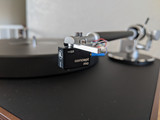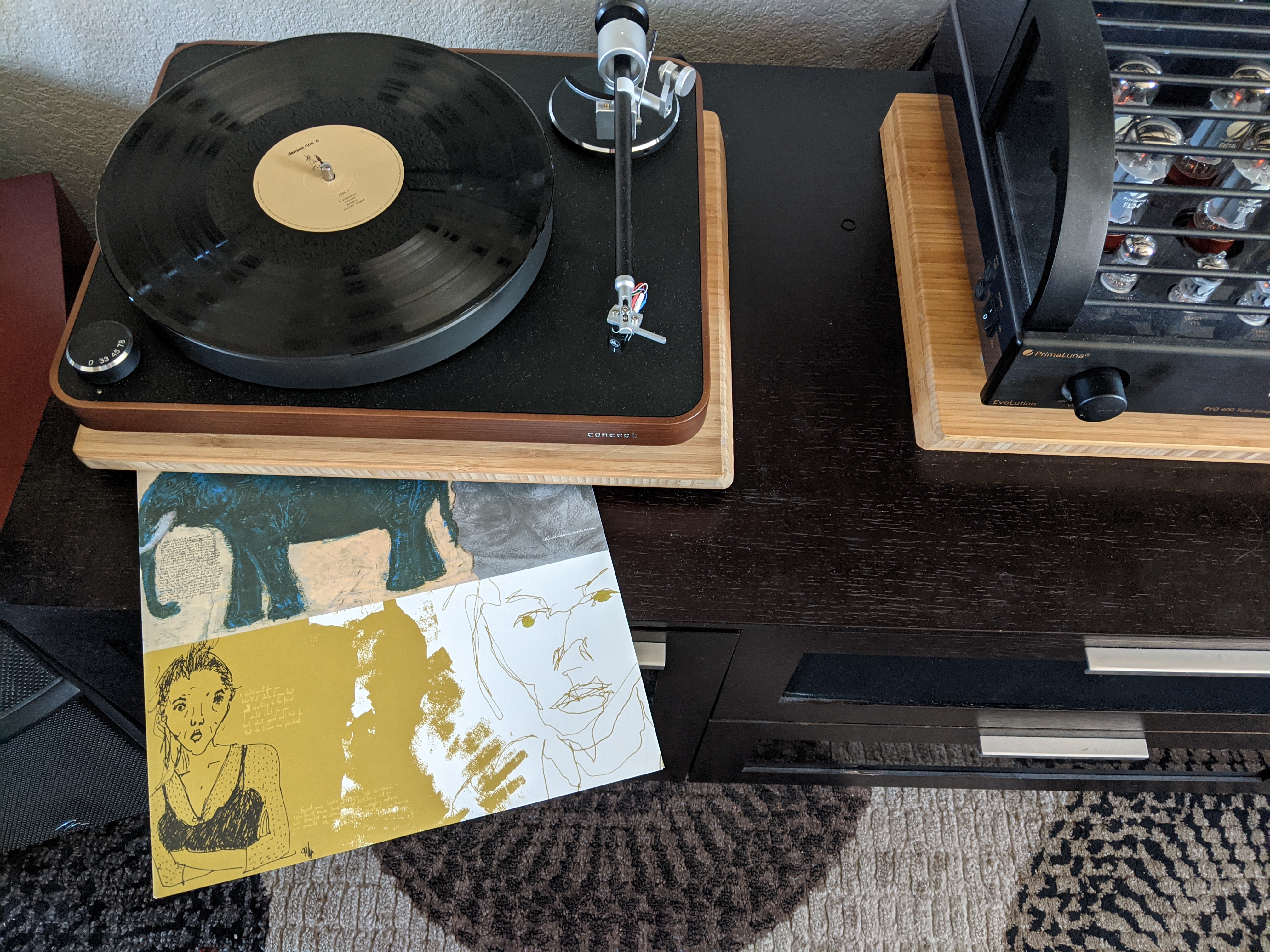Clearaudio Concept - Staff Review

Clearaudio Concept Review
Have you ever bought an album on vinyl and not listened to it because you keep telling yourself that your system isn’t ready for it yet? For me that album was Damien Rice’s “O”. I listened to it over and over in high school, it barely left my car’s CD player during my senior year (although that could partially be due to the fact that my 5-disc changer was located in the trunk, remember those?). I hadn’t really listened to it in years, but when it was announced that it was getting a special limited vinyl release, I knew I had to preorder it immediately. So I kept telling myself that as soon as I got a better phono stage, I would finally listen to it. Then once the phono upgrade happened, it was “I’ll listen to it when I upgrade to that tube amp I’m meaning to buy.” Well that finally happened and it still sat on my shelf. So, when I was asked to evaluate the Clearaudio Concept for the website I finally decided that I had run out of excuses; its time had finally come.
Setup
The Concept is one of the easiest turntable setups I’ve done in a long time. It came nearly fully assembled right out of the box - in this case with the upgraded Satisfy tonearm and a pre-mounted Concept MC cartridge The only thing for me to do was place the belt over the motor, slip the platter on and adjust the downward tracking force. Clearaudio even provided a bubble level and a force gauge right out of the box, certainly a nice touch, and fortunately for me the level was spot on and no adjustments to the feet were needed. I decided not to rely on the force gauge out of the box. It was nice that it was included, however, I’ve never been a fan of the small analog “see-saw” type designs and opted instead to use my electronic gauge. I wanted the best performance possible and decided not to leave any element to chance. A few quick adjustments to my Nova III phono preamp and I was ready to spin some vinyl.
Listening
I gave the record a quick brush and a shot from my anti-static gun and dropped the needle on Damien Rice for the first time, and immediately something was wrong. It sounded too thick, almost sludgy, and the bass was way too heavy. I double checked everything. Tracking force? Correct. Is it level? Perfectly. Speed is accurate? Completely. Then I went to my subwoofer and turned it down just a notch, suddenly everything snapped into focus, imaging was sharp and precise, Damien’s guitar notes seemed to float in midair. Voices were clean and natural and in no way over-emphasized as some vinyl can sound in my system. Most importantly, the bass was bold and present but not overly slow or thick. How can this be? How did this lighter turntable with its thinner plinth and platter create dramatically louder and tighter bass than my existing turntable? Halfway through the first side I stopped caring and was finding myself fully engaged in the music. Halfway through the second side I decided I was going to throw away all of my typical “test tracks” for this review. I ran back to my vinyl closet and started digging through, pulling out anything that I had a deep emotional connection to. I grabbed my all-time favorite records- they were all getting played.

I felt the urge to mix things up with my second album. As much as I love Damien Rice, I needed something a little more upbeat so I decided to go with Under the Table and Dreaming by Dave Matthews Band. From the first couple of snare drum hits on The Best of What’s Around I knew I was going to have a good time with this album. The drums were incredibly snappy with excellent articulation. They also had a sense of weight and forcefulness all without feeling slow or sludgy, and those cymbal hits! There was an added sense of both shimmer and clarity, all without the slightest hint of grain or glare in the sibilance range, I was immediately engaged.
When people ask me to articulate the differences between digital and analog listening experiences, I am often fond of saying that good digital is able to command your attention while analog better allows you to bathe in the music. I was quickly realizing that the Concept’s best quality was its ability to command my attention just as well as all but the most expensive digital front ends that I’ve experienced.
Next up was Jeff Buckley’s Grace. One of the things I love about vinyl is the inability to easily or conveniently skip tracks. I know this sounds crazy to some but I honestly believe (especially in the age of cell phones and instant gratification) that sitting down and listening to a full album front to back gives us a larger appreciation of not just the music itself, but of the artist’s vision for their work. That being said, I was so eager to hear “Lover, You Should Have Come Over” that I immediately flipped to the B-side and queued up the second track. There are few songs I’m aware of that hit quite the same emotional apex as this one, and I figured it was the perfect opportunity to get a better feel for the table’s sense of pace, rhythm and timing. This track was as free flowing and effortless as I have ever heard it. The vocals were extremely focused and much more palpable than I expected. I remember being blown away by Jeff’s vocal range when I first listened to this album 15 years ago at a friend’s recommendation (I was admittedly pretty late to the Jeff Buckley party). The concept didn’t show a single hint of a struggle at recreating even his highest vocal notes with a sense of weight and impact, not words I use often to describe falsetto. There was also a much better sense of clarity and separation amongst the guitar tracks, it wasn’t something I was actively listening for, but a pleasant surprise nonetheless.
I decided I wanted to really test out the Concept to gauge its full potential, so I grabbed my 45 RPM 200 gram pressing of Counting Crows’ debut album August and Everything After. Some people may be pretty surprised to hear this, but this is one of those albums that even some really good stereos can struggle with unexpectedly, especially in the imaging and sound staging department. Many of the smaller details can get buried in the layers of the more complex tracks like “Rain King and A Murder of One”. Much of my earlier observations around focused vocals and snappy drums still remained but the biggest feat for the Concept so far has been its ability to emphasize the mandolin tracks, it’s the hardest element to get right with this album, and the Concept was able to separate and define the instrument better than any turntable I’ve evaluated so far at any price. So much so that I listened to Perfect Blue Buildings twice just to make sure I wasn’t imagining things. Any fuzziness I was used to hearing was gone, another important box checked off.
Continuing with the 45 trend I decided to give my copy of David Gray’s White Ladder a spin. My system has always recreated this album with what I refer to as the “Wizard of Oz” effect: David’s voice tends to sound like a big giant head floating over the soundstage. This was the truest test yet for vocal clarity. I noticed his voice was a little further back in the recordings than I was used to hearing. At first I wasn’t quite convinced that this was a significant improvement, however the more tracks I listened to, the more I realized that it felt much less like a looming presence and more like a live voice in front of me. Once again, the bass response in Please Forgive Me was both deeper and tighter than I was accustomed to- at this point I was convinced this extra low end extension wasn’t a fluke, and it was more than fair to say the Concept passed the vocals test. This was when I decided to put my notebook down, I spent the next few hours not listening critically but instead simply for the enjoyment of it. I did have a long list of favorite albums to get through after all.
Conclusion
Very few audio components these days are able to fill dual roles. Most are either budget-minded units designed to provide good sound quality at a price that most people can reasonably afford or alternatively they are “end game” level models designed to be so good that you would never want (or be able to afford) to upgrade. But is it possible for something to be both? I would argue that the Concept is good enough (and provides enough upgrade opportunities in the way of tonearm options and outboard power supply upgrades) to be an “end game solution” for 90% of audio enthusiasts out there, while also still being affordable enough that most of us could reasonably add one to our system. All observations on sound quality aside, this is the type of turntable that will make you want to go back through your record collection over and over again, and at the end of the day, I can’t think of any higher praise I could give than that.
Associated Gear
MartinLogan Impression 11A
Musical Surroundings Nova III Phono Pre
Musical Surroundings Linear Charging Power Supply
Primaluna Evo 400 Integrated
Furman Elite 15 PFI
